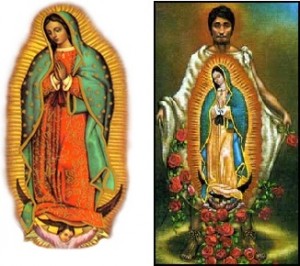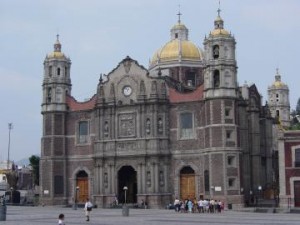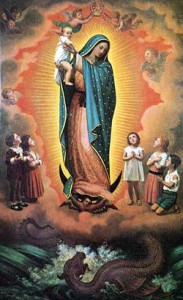“Hear me and understand well, my son …”
Posted by SociusDec 12
Today, Thursday, 12 December, is the Feast of Our lady of Guadalupe.
Christians worldwide are very well acquainted with the many beautiful feasts arranged annually in honour of Our Blessed Lady, but one of the most charming, in my humble view, is that of Our Lady of Guadalupe – largely speaking, I think, because throughout all of the events occurring in 1531, on the road to Mexico City, it is Mary who takes charge. She has a message for us!
 |
It is She who approaches a poor peasant on his way to Mass; it is She who asks that a church be built in her honour at that place; it is She who convinces a very sceptical bishop of her appearances and her wishes; it is She who works miracles of healing; it She who implants her most beautiful image on a humble peasant’s tilda (cloak); it is She who makes a promise that leaves no doubt She is in charge:
“Hear me and understand well, my son the least, that nothing should frighten or grieve you. Let not your heart be disturbed. Do not fear that sickness, nor any other sickness or anguish. Am I not here, who is your Mother? Are you not under my protection? Am I not your health? Are you not happily within my fold? What else do you wish? Do not grieve nor be disturbed by anything.”
All this happened in the winter of 1531, on the road to Mexico City. Juan Diego, a very poor 57 years old peasant, who lived about five miles from the City, was on his way to morning Mass when he heard music coming from above him on the hill, called Tepeyac Hill; even more surprisingly, a female voice was calling to him from out of the music. Juan climbed a little higher and he then saw a lady, dressed apparently as one of his own people, at which point the lady told him she was the Virgin Mary, and that she wished him to go and see the bishop and ask that a church be built on the Tepeyac, in her honour, to assist in the conversion of the people of that country, and to be a source of consolation to all the people.
Juan, still flabbergasted, no doubt, did as Our Lady asked, but the bishop was not impressed. Recognising Juan as a poor, but devout Catholic, he was not prepared at that point to believe in the Virgin’s appearance – or her request for a church – and Juan was forced to return to the Teypeyac, and the ‘Lady’, ‘empty-handed’. She told Juan to go back to the bishop and repeat her request, and at this, the bishop told Juan he should ask the Lady for a sign that she was the Mother of God, and that she wished a church to be built there. When he returned to the hill, Mary gave Juan Diego the sign that was needed. Quite miraculously, roses appeared, blooming on the hill in the middle of winter, and Juan gathered the blooms in his tilma, or cloak; Our Lady then arranged the roses, in his tilma, with her own hands, and Juan returned once more to see the bishop. When Juan opened his tilma, allowing the flowers to fall to the floor, it was revealed that a miraculous image of Our Lady had imprinted itself on his tilma.
 |
The bishop, Bishop Fray Juan de Zumarraga, fell to his knees when this happened and came to believe in Juan Diego’s message. A church was built on the site of the apparition, as Mary had requested, and millions of people became converted to Catholicism, upon hearing the accounts of what had taken place at Tepeyac; the news concerning an ordinary peasant, the appearances to him of Our Lady, the erection of a church in her honour and all this plus a ‘miraculous’ image of Our Lady, took that part of the Americas by storm. In time, the importance of the events was to take the story to a worldwide audience, and all of this many decades before the later appearances of Our Lady at Lourdes and at Fatima. Again, similar to the two aforementioned Holy Places, to Our Lady of Guadalupe are attributed an incredible number of miraculous cures and interventions, worldwide, but especially in the Americas; she is honoured and venerated by Catholics – and Christians – millions of them in every continent.
The tilma worn by Juan Diego was an ordinary peasant garment, over six feet in length and almost four feet wide, woven out of coarse cactus fibre with a life-span of no more than, perhaps, 20-30 years; experience says it should then have fallen apart, through age, but today, almost 500 years later, it is still intact and shows no sign of disintegration. Superimposed thereon is the exquisite and delicate figure of Our Blessed Lady, an image of almost 5 feet in height. It has been examined using all the modern techniques, and here it bears remarkable similarities to the Shroud of Turin, in that no paint was used, and chemical analysis has not been able to identify the colour imprint, or how it was applied to the cloak. Perhaps, even more remarkably, it is said that the pupils of Mary’s eyes, in the picture, reflect the people present at the time of the first sight of the image, and that the stars on Our Lady’s mantle match exactly the stars of a Mexican sky of December, 1531.
Today it hangs above and behind the High Altar, in the Basilica of Our Lady of Guadalupe in Mexico City, a place of honour visited by millions of pilgrims, annually, to venerate and to pray before Our Lady, “Santa Maria de Guadalupe” – a title chosen by Mary, herself, and her Sanctuary has been visited officially by many, many, Holy Fathers as one of those most ‘Holy Places’, significant in the annals of Christianity.
 |
The Basilica of Our Lady of Guadalupe, Mexico City
In 1895, by decree of Pope Leo XIII, the Image of the Blessed Virgin of Guadalupe was crowned with great solemnity. In 1945, on the 50th anniversary of that crowning, Pope Pius XII proclaimed her Patroness of all the Americas. Pope John Paul II travelled no less than four times to visit Our Lady at the Sanctuary, the first in 1979 – his first outside Rome – and then again in 1990, 1999 and 2002. In 1999, he declared Our Lady of Guadalupe’s feast day, 12 December, to be a Liturgical Holy Day for the whole of the Continent of South America, at the same visit, entrusting to her care, the ’cause of life’, the innocent lives of children throughout the world, especially those in danger of not being born. The picture below portrays her patronage beautifully:
 |
Our Lady of Guadalupe – Pray for us.
Socius

No comments